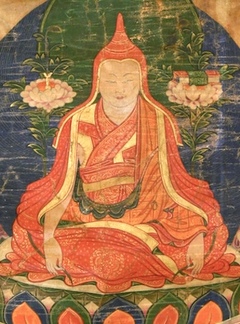Great Guide to the Supreme Secret Path
Great Guide to the Supreme Secret Path
by Longchen Rabjam
oṃ āḥ hūṃ
At the feet of the venerable guru, I pay homage.
Herein I shall draw together and write down for posterity’s sake
The profound key points for the stages of instruction
From the unwritten and secret sphere.
This has three parts: (1) preliminaries, (2) main part, and (3) conclusion.
1. Preliminaries
This has seven parts.
1. Guru Yoga
This entails visualizing the whole of appearance and existence as the realm of Samantabhadra, consider that the root and lineage gurus amass above the crown of the head and praying to them.
2. Maṇḍala Offering
Heaps for the four continents and Mount Meru are arranged. They are visualized as a buddha realm with all the enjoyments of gods and human beings, and offered.
3. Yoga of Vajrasattva
The yoga of Vajrasattva involves visualizes white Vajrasattva holding vajra and bell, with the hundred syllables at his heart, and reciting the mantra.
4. Integrating the Impermanence of Life
This involves contemplating the external, the changes of the four seasons; the internal, the transformations of the aggregates; and the secret, the idea that this is the bardo.
5. Disenchantment with Saṃsāra
This consists of contemplating the sufferings of each of the six classes of beings.
6. Cultivating Bodhicitta
Cultivating bodhicitta involves meditating alternately on giving away one’s own happiness to sentient beings, who extend to the limits of space, and taking all their suffering upon oneself. There is also the cultivation of great compassion.
7. Threefold Investigation of Dualistic Mind
First, there is the training in how the five outer objects of perception lack true existence. This involves meditating on the fact that all the phenomena that appear as the five types of sensory object are like illusions or dream phenomena insofar as they appear yet are unreal. From the very moment they appear, they lack support and have the nature of non-abiding space. The thorough investigation of the inner perceiving mind involves examining the mind that denies and affirms and in which thoughts arise—its initial place of origin and what it is that originates; its subsequent place of continuation and what it is that remains; and its final destination and what is that departs; as well as its shape and colour and perceptible identity. Through this, one realizes that mind is like space. This demonstrates the equality of saṃsāra and nirvāṇa.
It is vital to become extremely proficient in these preliminaries.
2. Main Part
This has two parts.
1. Primordial Purity
To introduce primordial purity as the dharmakāya, so that it may be experienced here and now, arrange tsok offerings and tormas, offer prayers, adopt the key points of the physical posture, invoke the whole lineage, and employ the following formula:
Look into the naked essence, the unimpeded self-cognizant awareness of the present moment. It is lucid and non-grasping. It is empty, devoid of self. It is intangible awareness. This is the dharmakāya, so do not waver from such an experience. Sustain it just as it is, without spoiling it through alteration.
2. Spontaneous Presence
To introduce spontaneous presence as luminosity brings liberation in the bardos. For this, use a crystal refracting a sunbeam as it passes through a skylight to point out the nature of the original ground, how Samantabhadra is liberated, how ignorant sentient beings become confused, the nature of mind and primordial wisdom, how to put the instructions into practice, and how to gain liberation in luminosity during the bardos. Then close the skylight and, with the aid of a woman, introduce entrance, remaining and withdrawal. Set out a symbolic circle on the ground, raise it with the crystal, and introduce it through example, referent and sign.[1] Then introduce the three kāyas based on crystal, sun and image. Introduce the dharmakāya using the crystal, the sambhogakāya using the image, and the nirmāṇakāya using rays from the sun, following the lineage of practical instruction. Light beams from the crystal as it is held aloft in sunlight serve to introduce the channel linking the heart to the eyes. They can also introduce the moment that mind and wisdom separate, the ground appearances of the bardo, and the way that sounds, lights and rays emerge.[2] This also neatly illustrates how, since the kāyas and wisdoms remain inseparably within the spontaneously present, precious sphere, the outwardly radiant sambhogakāya acts for others’ sake while remaining as inwardly luminous dharmakāya.
These are the major instructions for the paths of all three lineages of whispered transmission.
3. Conclusion: Supporting Instructions
Explain the supporting instructions in an appropriate level of detail and then apply the injunctive seal of secrecy.
Through the merit of setting out this great guide
To the unwritten, whispered lineage in this way,
May all beings embark upon this most sublime of vehicles
And reach the level of the supreme victor Samantabhadra.
This concludes Great Guide to the Supremely Secret and Unwritten Whispered Transmission by Natsok Rangdrol, a yogin of the natural Great Perfection. May it be virtuous! Virtuous! Virtuous!
| Translated by Adam Pearcey with the generous support of the Tsadra Foundation, 2025.
Bibliography
Tibetan Edition
klong chen rab 'byams pa dri med 'od zer. "mchog gsang lam khrid chen mo" In gdams ngag mdzod. 18 vols. Paro: Lama Ngodrup and Sherab Drimey, 1979–1981 (BDRC W20877). Vol. 2: 247–251
klong chen rab 'byams pa dri med 'od zer. "mchog gsang lam khrid chen mo" In snying thig ya bzhi. 13 vols. Delhi: Sherab Gyaltsen Lama, 1975. Vol. 13: 51–55 (2.5 folios)
Secondary Sources
Jamgön Kongtrul. Nyingma: Mahayoga, Anuyoga and Atiyoga Part Two. Translated by the Padmakara Translation Group. Boulder: Snow Lion, 2024.
Version: 1.0-20250611
